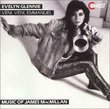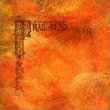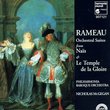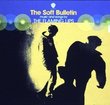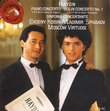| All Artists: Laszlo Hadady, Pierre Boulez, Ensemble InterContemporain Title: Luciano Berio: Corale (Sequenza VIII), for Violin, 2 Horns & Strings / Chemins II (Sequenza VI) / Chemins IV (Sequenza VII) / Ritorno degli Snovidenia, for Cello & Small Orchestra / "Points on the Curve to Find...", for Piano & 22 Instrumentalists - Pierr Members Wishing: 0 Total Copies: 0 Label: Sony Original Release Date: 1/1/1991 Re-Release Date: 2/8/1991 Genre: Classical Styles: Chamber Music, Forms & Genres, Concertos, Instruments, Keyboard, Reeds & Winds, Strings Number of Discs: 1 SwapaCD Credits: 1 UPC: 074644586220 |
Search - Laszlo Hadady, Pierre Boulez, Ensemble InterContemporain :: Luciano Berio: Corale (Sequenza VIII), for Violin, 2 Horns & Strings / Chemins II (Sequenza VI) / Chemins IV (Sequenza VII) / Ritorno degli Snovidenia, for Cello & Small Orchestra / "Points on the Curve to Find...", for Piano & 22 Instrumentalists - Pierr
CD DetailsSimilarly Requested CDs
|
CD ReviewsStunning modern concertos R. Hutchinson | a world ruled by fossil fuels and fossil minds | 06/30/2003 (5 out of 5 stars) "Boulez and his Ensemble InterContemporain here perform 5 concertos by Berio (may he rest in peace!), and it is a stunning tour de force! The works, composed between 1967 and 1981, feature cello, viola, oboe, violin and piano respectively. I'm not familiar with the other soloists, but it is Pierre-Laurent Aimard, well-known for his recent recordings of Messiaen and Ligeti, that plays on the piano concerto. The recordings were made at IRCAM in April of 1989 under Berio's supervision, and the disc was first released in 1990. The cello concerto was commissioned as a feature for Mstislav Rostropovich, and the title, which translates as "Return of the Dreams," indicated for Berio a reconciliation between his idealistic and Rostropovich's decisively negative view of the Russian Revolution. The piece incorporates three fragments of Russian revolutionary songs, and is "a hommage to a dream betrayed," in Berio's words. None of the other works have such an interesting story behind them. "Chemins" means "paths," and the method of these pieces is to take a solo line and proliferate orchestral responses from it in layers. The "Corale" for violin uses this method along with the "Chemin" for viola and oboe -- Berio called it "Corale" because the responding strings were in the same voice as the solo instrument unlike the other two. "Ritorno" and "Points On a Curve" utilize another method, also involving a solo line and response, but generating "waves of harmonic undulations in such a way as to define a slowly changing reservoir of pitches." To the extent that these techniques are clear to me at all, it is thanks to the excellent liner notes of David Osmond Smith. Fortunately these works are beautiful regardless of whether their construction is understood. Berio combines a lyrical sensibility with atonality and the most complex and original of compositional techniques. If you have heard and enjoyed, for instance, last year's outstanding recording of VOCI by Kim Kashkashian on ECM (see my 7/28/02 review), you are likely to enjoy these concerti." A splendid combination of simple colour and ingenious concep Christopher Culver | 07/31/2006 (5 out of 5 stars) "The five concerto-like works by Luciano Berio on this Sony disc, performed by the Ensemble Intercontemporain conducted by Pierre Boulez, show the composer simultaneously exploiting every possibility inherent in one particular instrument and delighting in large and elegant orchestration. Three of the pieces are based on his solo "Sequenzas", and if you pick up this disc, you'll want a recording of the Sequenzas as well--the DG recording features the same ensemble as here, while the Naxos recording is budget-priced but high-quality.
"Chemins II" for viola and nine instruments (1967) is based on "Sequenza VI" for viola written earlier in the same year. The solo work was essentially a study in repetition, where the violist plays tremolo multistops elaborating on the same basic harmonic fields, with little snippets of melody appearing here and there and ultimately winning out in the end. The music was aggressive, with virtuoso challenges that made a clear nod to Paganini. For the orchestration that is "Chemins II", Berio has electric organ, pitched percussion, and strings joining the viola in the harmonic process, while flute, clarinet, and trombone go there own way, with the effect that the original Sequenza feels both expanded and "swallowed up". The solo violist here is Jean Sulem. "Points on the curve to find..." for piano and 22 instrumentalists (1974) seems the most "abstract" of the pieces here. The pianist plays a undulating series of notes in demisemiquavers, and each note is elaborated upon by the instrumental ensemble. Despite the eggheadedness of its design, a clear feeling of alternative expansion and contraction is clearly audible. The piano part here is performed by Pierre-Laurent Aimard, who as always tackles demanding repertoire with a sense of comfort and ease. "Chemins IV" for oboe and ensemble (1975) is based on "Sequenza VII" for oboe written in 1969. Like "Sequenza VI" and its subsequent Chemins, both of these pieces are based on a sort of repetition. In the Sequenza, the oboe starts from a single note, B, and explores a limited number of intervals, though with all manner of timbres throughout. But the range of pitches slowly expands until finally two-thirds of the way through G is heard, where upon the furious osscilating ends and we get a musing exploration of a small range. In "Chemins IV", the original structure is preserved intact, with the oboe still in the spotlight but with cooperation from other instruments, some of which take over for a few bars while the oboe holds back. Here the oboe part is performed by Laszlo Hadady. "Ritorno degli snovidenia" for cello and small orchestra (1976-77) was written for Mstislav Rostropovich. While the famous cellist was a bitter critic of the Soviet Union, Berio had an attitude of idealism towards the Russian revolution, and saw its dream crushed only later by Stalinism. He wanted to express the idea of "betrayal" in musical terms. Well, I can't here anything that concrete here. Instead, the piece continues the technique heard before in "Points on the curve to find..." of generated harmonies from a central melodic line, with the idea of nostalgia communicated by repeated cells and returns to previously heard material. In a way, this is the most beautiful piece of the works here, with softly bubbling textures and a passionate cello line, performed in this recording by Pierre Strauch. The latest piece on the disc is "Corale" for violins, two horns, and strings (1981), based on "Sequenza VIII" for solo violin. This is another orchestration that keeps the original Sequenza intact. Where the solo piece had the violinist playing a chaconne on two notes, A and B, occasionally darting off into new melodic lines before returning to the basics, "Corale" simply expands this with more strings and horns. The occasional pauses found in the Sequenza are here filled out with original material. This probably has the clearest dramatic arc of the five pieces, and at the end the most impressive forces are not the violin (played here by Maryvonne Le Dizes) and strings, but the horns who almost heroically rise above the orchestra. The way in which each of these pieces encompass a whole world of timbres and attacks while still faithfully revolving around one central idea is fascinating. The best introduction to the music of Luciano Berio is certainly his "Sinfonia" (with a great new recording recently out on DG), but for those interested in his work, highly personal yet always based on intriguing theory, these five concertos and the "Sequenzas" are a must-have." |

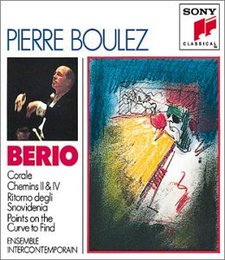
 Track Listings (5) - Disc #1
Track Listings (5) - Disc #1